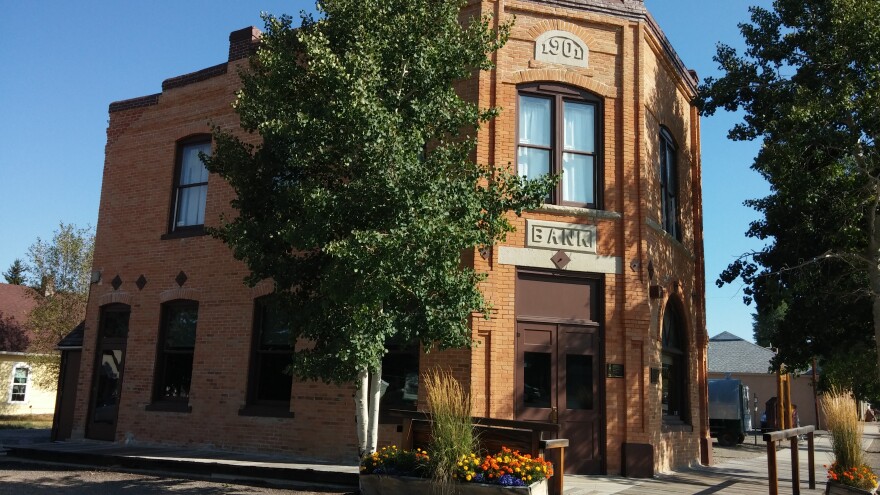The Jim Gatchell Memorial Museum in Buffalo and Meeteetse Museums both lost federal funding when the Trump administration terminated National Endowment for the Humanities (NEH) grants across the country earlier this year. They’ve since made up the difference, but staff are now thinking twice about seeking out those sorts of grants moving forward.
Meeteetse Museums
Last year, Meeteetse Museums received a little over $100,000 to fix a leaky roof and install solar panels to cut down on utility costs. While the roof replacement wrapped up at the end of 2024, the last $10,000 of the solar panel funding was abruptly terminated at the start of April.

But later that month, NEH announced that impacted organizations could submit appeals for termination and reimbursement costs. Meeteetse Museums Executive Director Alexandra Deselms filled out the form and made her case.
“ We had signed the contract with the solar company in November of 2024, so we were liable for those costs,” she said. “They'd already ordered the materials, they were sitting in the warehouse.”
The request went through and Meeteetse Museums was able to complete the solar installation project. The panels are now running and saved roughly $300 in June and $400 in July, according to Deselms.
The executive director said it’d be “nice” to apply to other NEH, National Endowment for the Arts or Institute of Museum and Library Services grants in the future, but she also feels leery about trusting the process.
“ We just had our funding taken away. Do we really want to put ourselves through this?” she said. “ What happens if we start the project and it's something that we can't find funding for? Do we have to stop in the middle? Or if we hire somebody, are they just out if something happens?”
There’s three separate museums under the Meeteetse Museums umbrella: the Charles Belden Museum of Western Photography, the Meeteetse Museum and the First National Bank Museum.

Meeteetse Museums is still planning to work directly with the Smithsonian Museum for its Many Voices, One Nation project, as part of the 250th anniversary of the United States next summer. The exhibit is a collaboration of Smithsonian materials with site-specific local customization.
Wyoming Humanities had previously been sponsoring and coordinating the project with museums across the state. But NEH cuts gutted the organization this spring and it’s no longer able to participate.
The Jim Gatchell Memorial Museum
The Jim Gatchell Memorial Museum in Buffalo lost $20,000 of funding for a grant to better tell the story of the area’s Indigenous peoples as a result of NEH cuts this spring. The project aimed to collaborate with tribal representatives from the Northern Cheyenne, Northern Arapaho, Eastern Shoshone, Lakota and Crow tribes to re-interpret the museum’s Indigenous-focused gallery.
That funding was ultimately replaced by about $7,500 of support from Johnson Country’s 1% sales tax funds via the county commissioners, along with a sizable donation from an anonymous donor.
Executive Director Sylvia Bruner said receiving the initial grant funding before the cuts was especially exciting, given it was the museum’s first grant from the federal government.
“We were really excited and then to have that excitement pulled away, that was an experience,” she said. “But we're definitely very aware of and grateful for the fact that nothing here has actually been stopped.”
The museum plans to meet with the project’s Native Wisdom Council this fall to hear feedback and figure out next steps.
According to Bruner, losing the NEH grant had an unexpected silver lining – the ability to take time working on the project, rather than having to meet the grant’s two-year time limit.
“Giving us the breathing room to arrange for meetings and to do that on everybody's schedules instead of trying to rush into something – honestly, that's not a bad thing,” she said.
But like Meeteetse Museum’s Alexandra Deselms, Bruner said she’s not looking into any other federal grants right now.
“It has certainly given me a feeling of insecurity with that, because my basic understanding was that it was a contract and we held up our end of it,” she said. “We submitted all the paperwork, we had all of our ducks in a row for it, so it makes me wary to consider getting into another contract grant award agreement.”
Like Meeteetse Museums, the Jim Gatchell Memorial Museum is also moving ahead as a host for the Smithsonian’s Many Voices, One Nation project. Bruner said the current plan is to have one of the main themes of the exhibit be about brain drain in the state, and specifically in Buffalo and Johnson County.
“Why do our young people go through school here and then leave? What kind of opportunities are not here for them to stay?” she said.
The topic suggestion came directly from some of the museum’s summer employees, who are high school students.
“Our high schoolers were the ones that were like, ‘I want that, I want you to talk about this. This is really interesting and pertinent to me as a young person,’” said Bruner.




